
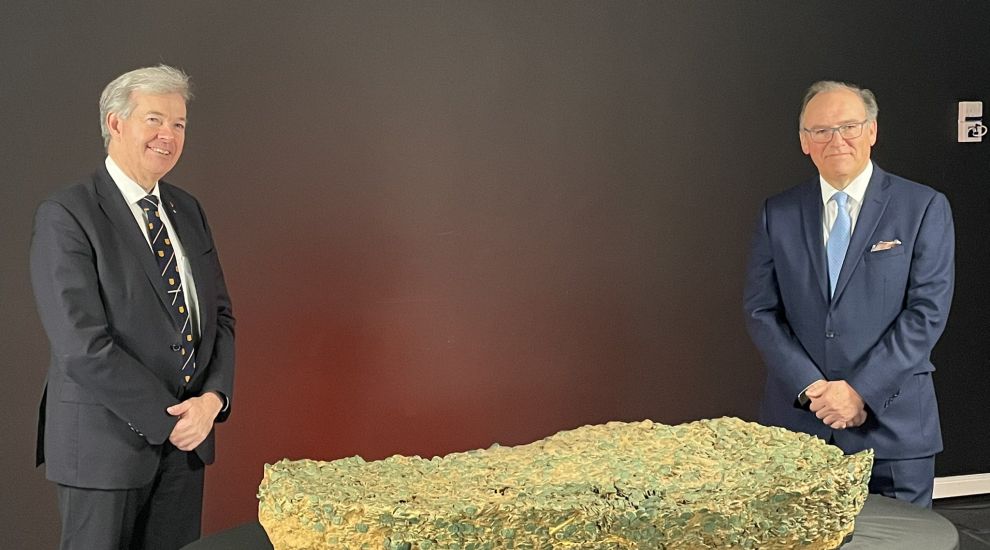

Experts in the UK tasked with valuing the record-breaking 2,000-year-old Le Câtillon coin hoard started with a figure of £2m…so how did the island end up paying more than double, against the recommendations of Jersey Heritage and senior Government civil servants, including the CEO?
Express digs in to the process to purchase the island’s most significant historic find…
The Le Câtillon II Coin Hoard treasure trove includes:
In the UK, there is a specific Treasure Trove Act, which sets out a clear process for how finds are offered for sale to institutions while finders, such as metal detectorists, and landowners are ‘rewarded’.
The idea of having a clear process is to encourage anyone who stumbles upon - or carefully researches and triangulates - a find of historic importance to declare it so that it can be preserved for future generations, rather than simply sold on to the highest bidder.
Believing that the island could potentially be a hotbed for hoards, Jersey Heritage and other members of the island’s research community have for many years been calling for such a law.
One is now being drafted, and is apparently due to be lodged and debated next year.
But that comes many years too late for Le Câtillon II, a clump of Celtic treasure including gold torques silver coins, and jewellery discovered by Richard Miles and Reg Mead in a field in Grouville in 2012.
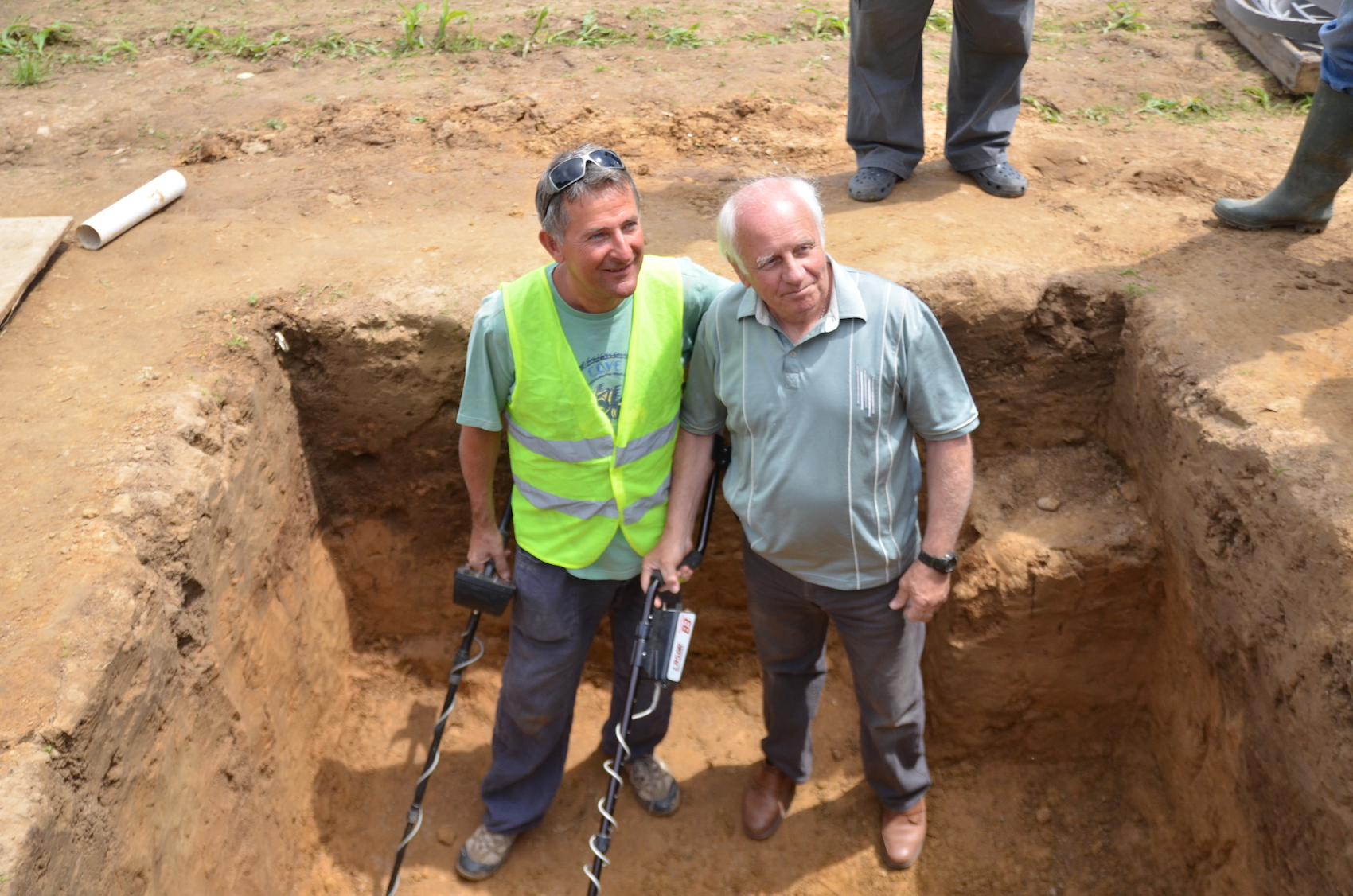
Pictured: Finders Richard Miles and Reg Mead, who discovered the hoard in a field in Grouville in 2012.
With no law in place, Jersey instead decided to follow the “spirit” - not quite the letter - of the UK law.
Whenever ‘treasure’ is found, the UK law says that a body of boffins called the ‘Treasure Valuation Committee’ (TVC) should value it.
The independent team, which holds its meetings at the British Museum, is a collective of the UK’s top antiques and coin experts and metal detecting specialists.
At this point, the ‘treasure’ is officially owned by the Crown (that is to say, the Queen), who is represented in land and property transactions in Jersey by the Receiver General, who at present is Alan Blair (pictured top, right).

Pictured: The TVC holds meetings at the British Museum.
It is for the Receiver General and the body wishing to acquire the ‘treasure’ (in this case, Jersey’s Government on behalf of the public) to then agree a sale price, which includes a ‘finder’s reward’ which the Receiver General will then pass on.
In 2017, the TVC’s top coin minds were asked to study Jersey’s hoard.
Their engagement, Express understands, caused much excitement in the historic research community. It was the first time the island had linked up with the prestigious body - and was, in a sense, a ‘test’ of how treasure valuations could be undertaken as part of a fair and equitable process with a new Jersey-specific Treasure Law.
Indeed, the TVC has a history of close working with fellow Crown Dependency, the Isle of Man, which only introduced a Treasure Act in 2017.
As recently as July, the TVC was called to analyse a 350-year-old gold ring found by a Manx metal detectorist.
Normally, it would be expected that the period between the find being made and an ex gratia reward being paid should be no more than 12 months, but there are exceptions for particularly large hoards of coins.
That’s because they are usually ‘clumped’ together when found, and unpicking each element of the hoard to determine its exact value is a painstaking, technical process.
Pictured: The lab where the coins were extracted one by one.
Each of the near-70,000 coins in Jersey’s trove had to be carefully extracted, one by one.
A team of researchers led by conservator Neil Mahrer - armed with a £40,000 laser scanner to map out every millimetre of the mud-logged clump in three dimensions - pored over the hoard over a period of around three years, removing around 500 coins per week.
By 2017, the TVC was finally able to take a good look at it.
They concluded that the island should pay £1,977,200 to acquire it - an offer that was communicated to Jersey Heritage and the Receiver General in November 2017 and January 2018 respectively.
The figure was backed by senior civil servants as being appropriate and reasonable.
Importantly, the TVC valued the hoard as a collection - not as individual items. Why? Because, for the public, the historic and cultural value was in the whole, not the sum of its constituent parts. (And, let’s face it, its touristic potential too.)
Never before had such a large collection been found - the hoard of 69,347 coins even broke the Guinness World Record for ‘Largest collection of Iron Age coins discovered’ in 2020.
What sounds better, the world’s largest hoard? Or a fragment of it?
Whether their focus was historic or economic, it was clear to those familiar with discussions at the time that breaking up the collection, would be to water down one of the most important discoveries in Jersey’s history; it would be nothing short of a scandal.
The finders, however, decided to pursue a separate valuation.
Under Paragraph 67 of the UK Code of Practice, “all interested parties” - whether finders, landowners or any museum wishing to acquire the find - “have the right to submit their own evidence” to the TVC for consideration.
The finders recruited UK Celtic coin dealer Chris Rudd Limited.
The business - which is the “only dealer who deals only in Celtic coins” - is run by Elizabeth Cottam, who “comes from a family of collectors and dealers”, “with the help of a semi-retired Chris”.
“Though Elizabeth respects and relies on numismatic research, Celtic Liz believes that collecting and studying Ancient British coins should be fun, for her as well as her clients. ‘Yes, I’m in business for profit,’ she says, ‘but I’m in Celtic coins for pleasure.” the website reads.
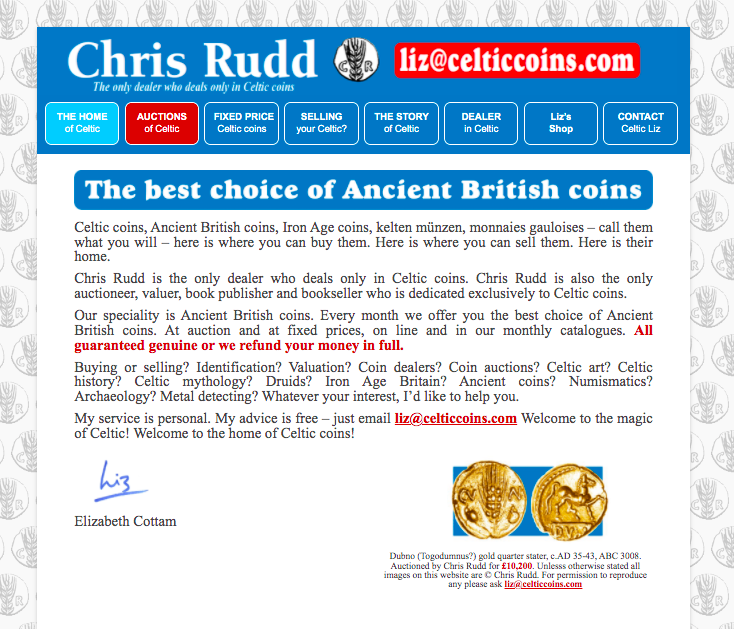
Pictured: A screenshot from the website.
“Whilst she acknowledges that Ancient British coins can be ‘a good buy for a rainy day’, she doesn’t encourage investment collecting. Her advice is ‘Buy now and enjoy now. You could be dead tomorrow.’”
The specific advice on Jersey’s coin hoard, however, appeared to be that the valuation was too low - and that the coins should be valued separately.
It came in the form of a report spanning more than 800 pages, apparently with input from 19 experts who examined the condition of every single coin and object individually over five days in Jersey.
This examination was informed by an independent audit of Armorican coin prices preceding the visit.
Chris Rudd Limited was highly critical of the TVC’s valuation.
Whereas it had worked out around £20 per coin, Chris Rudd argued that the condition of the coins had a “substantial” effect on their value - so substantial, they said, that they tripled the existing valuation, to £6.1m.
The TVC did not revise their valuation in response to the report. They recommended that the Receiver General commission a further valuation.
In 2019, the Receiver General approached French valuers ‘CGB Numismatics Paris’, which describes itself online as the “top numismatic company in France” - where metal detecting is less popular, as it is a legal minefield - with “over 80,000 coins, banknotes and numismatic books for sale.”
They agreed with the £6.1m figure - but on the basis that the hoard was split up.
What followed was a lengthy argument about who was in the right, with senior civil servants fighting the corner of the TVC.
This largely stemmed from fears about the precedent that could be set by ignoring them, and offering significantly more to finders.
Having considered all evidence, the Receiver General decided to make an offer to sell the hoard at a value firmly in the middle - £4.25m - on 16 January 2020.
Richard Corrigan became Director General of ‘Economy’ - which includes responsibility for Culture, Arts and Heritage - in April 2020.
Having “inherited” the matter, he took time to come to his own conclusions, and formed the same opinion as his colleagues: the TVC’s suggestion of £1,997,200 was the right one.
While covid was a complication and served to slow down discussions, officers continued to argue their case.
During two crunch Council of Ministers meetings on the matter on 27 April and 15 June this year, they gave a clear and unequivocal recommendation, but it fell on deaf ears.
The decision did not sit well with Mr Corrigan.
On 17 November, he asked for a formal ‘letter of instruction’ from Ministers - a way of saying that the officer is not prepared to take legal responsibility for their decision.
While he said he respected the Council of Ministers’ wish to acquire the hoard at £4.5m “to ensure, beyond reasonable doubt, that a valuable piece of the island’s heritage has been secured”, he said he was unable to “reconcile this with my own legal responsibilities.”
Beyond suggesting a clash with his obligations under the Public Finances Law, he pointed to the Nolan Principles. The basis of ethical standards expected of public office holders, these are: selflessness, integrity, objectivity, accountability, openness, honesty, and leadership.
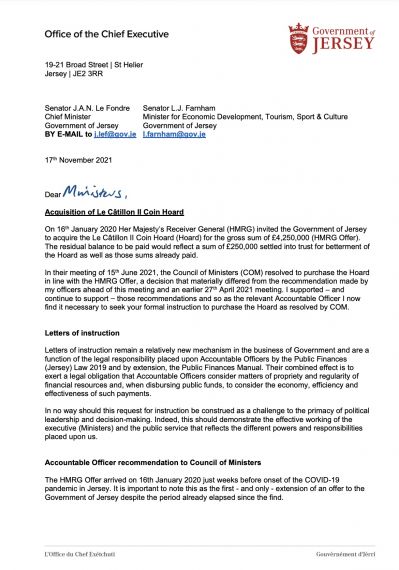
CLICK TO READ: Mr Corrigan's letter to Ministers.
Mr Corrigan also noted that his fears were shared by the Principal Accountable Officer, Interim CEO Paul Martin, who he quoted as saying: “I am at a disadvantage in this matter as most of the events described in this letter pre-date my arrival in post in March 2021.
“However, the interests of the public purse are served by a strictly commercial negotiation in which the Government’s focus is wholly on the interests of taxpayers and that does not exceed a reasonable and defensible valuation.
“I am also influenced by a meeting with the Chair and Chief Executive of Jersey Heritage and representations made by them to the Government.
“Finally, I am mindful of the risk of precedent being formed here. I therefore support the conclusion of the Accountable Officer.”
In essence, the question officials were asking was, who are we negotiating for? If it is the public the government is supposed to serve, the valuation cannot be right, they argued.
The Chief Minister’s response did not appear to answer the moral conundrum - but did offer a practical solution: splitting the difference.
At a press conference yesterday, he outlined his logic.
"Had it been decided to split the hoard into its component parts for sale to the highest bidders, considerably more money could have been raised and the treasure trove would have been dispersed across the world and its inherent value to Jersey lost," Senator Le Fondré said. (Remember that thing about not splitting it up?)
He continued: “The Crown was under no obligation to sell to the island and, although it has taken time, we have reached an agreement which satisfies the interests of the finders, the Crown and the island.”
His five-page letter officially ordering Mr Corrigan to carry out the transaction - sent jointly with the Treasury Minister on 17 December - provides further insight into his thinking.
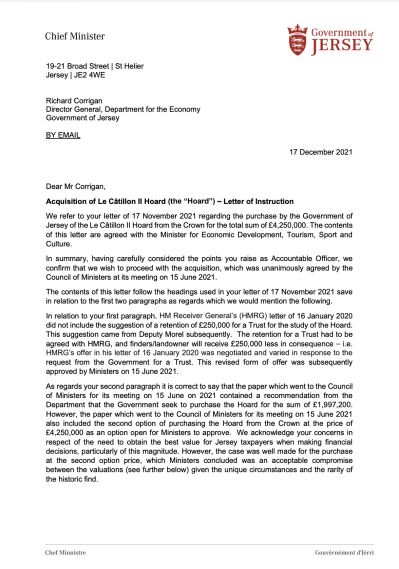
CLICK TO READ: The formal 'letter of instruction' reply from the Chief Minister to Mr Corrigan.
In it, he speaks of the TVC valuation being a “brief” two pages, “albeit that reports totalling over 60 pages were subsequently produced” and containing “arithmetical inconsistencies” - though does not state what these are.
He also points to the TVC’s analysis having only been carried out by three experts over two days, contrasting it with Chris Rudd Limited’s 800 pages put together by 19 “experts, who examined the condition of every single coin”.
Speaking to Express, Senator Le Fondré said that he had met with the finders “probably in 2018 or 2019” but that the topic of the conversations was never about finance - but “getting the thing resolved.”
“Certainly as far as I’m concerned, Ministers have not been involved in negotiations, and I don’t think that would be entirely appropriate.”
We do not know how much has been handed over to the finders, and how much, if any, retained by the Crown - the figure has been deemed “confidential”, and will not be made public.
What we do know is that, according to the Receiver General, “all parties consider the price paid to be fair and reasonable.”
That did not seem to be the view of future custodians of the hoard, Jersey Heritage, however.
“We are fully aware of the practice for valuing similar finds in the UK and have concerns that the ultimate price paid was so far adrift from expert advice from the UK’s highly-regarded Treasure Valuation Committee,” the charity’s Chair, Tim Brown, said.
“Such a conclusion could have a detrimental impact on Jersey reputation and endanger future acquisitions by setting a precedent for inflated valuations.”
Their concerns were echoed by archaeologist Dr Matt Pope, who has worked extensively on the Neanderthal site at La Cotte in St. Brelade.
“I find the non-acceptance of the Treasure Valuation Committee recommendation perplexing: it’s a fully independent body with established and trusted expertise in arriving at equitable rewards for responsible finders,” he told Express.
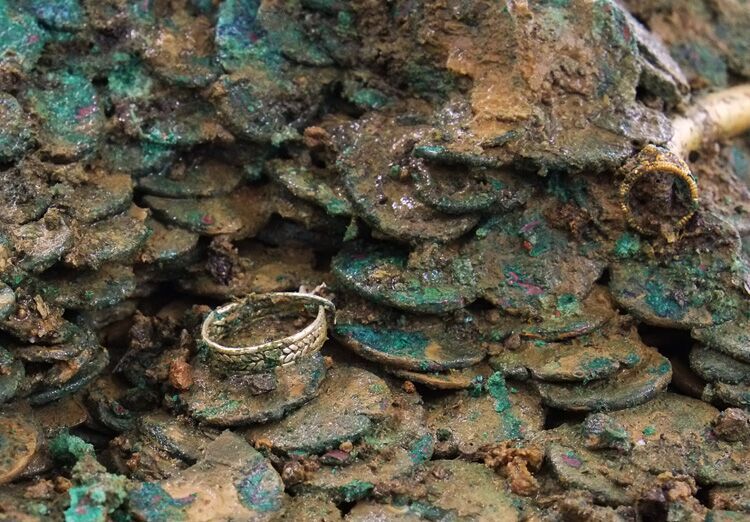
Pictured: Jersey Heritage said it was concerned the price for the hoard was "far adrift" from the TVC recommendation.
“Outcomes like this aren’t good for Jersey or the wider heritage community, it puts too much focus on the monetary value of ‘treasure’ and detracts from us celebrating and responsibly protecting Jersey’s past.
“Best practise was evident throughout Jersey Heritage’s work recovering the hoard, ensuring its meticulous conservation, interpretation and obtaining the TVC valuation.
“So, despite the outcome this time, which I fear will be counter-productive, I hope all stakeholders in Jersey recommit towards robustly enhancing protections for the island’s past.”
Award-winning television producer Jonathan Renouf, who spent 20 years working for the BBC’s Science Unit before returning to Jersey, described the government’s disregard for the TVC’s valuation as “disgraceful”.
He said the it was “nonsense” to argue that the Crown would not have accepted a smaller payment, as the Chief Minister had suggested.
The govt disregarded the valuation of the independent TVC in favour of one commissioned by the finders of the hoard. It is nonsense to argue that the crown wouldn't have accepted less money: the receiver general represented both the Crown & the finders. https://t.co/al3AaWvwyI
— Jonathan Renouf (@JonathanRenouf) December 23, 2021
The UK Treasure Trove Act Code sets out a right of review.
Any “interested party” who is “dissatisfied” with the TVC’s recommendation has the right to make representations before the Secretary of State within 28 days before an order is made. Their decision will then be subject to judicial review. Claims of maladministration, meanwhile, can be investigated by the Parliamentary Commissioner for Administration.
Remember, this isn’t Jersey law, but the government was clear that it would follow its “spirit”.
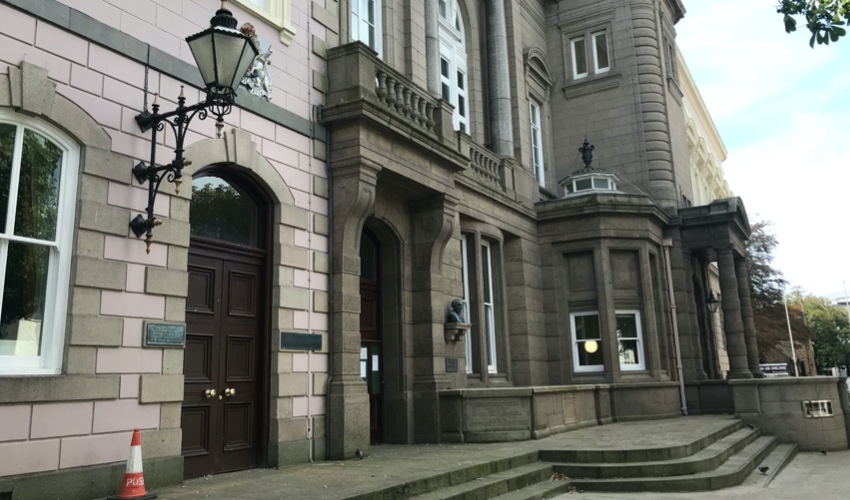
Pictured: The Chief Minister said a court battle could result in a higher cost.
In the Chief Minister’s construction, that means the Receiver General - rather than the TVC - has the final say on “procedure and decision making.”
He also appears to hint that a judicial review might be possible - but warns that it “could result in a higher valuation figure for the Hoard than £4.25m”, while also meaning legal costs.
It seems unlikely that the legal muscle will be flexed by any party, but there is always a question of political scrutiny - or challenge.
Indeed, Deputy Montfort Tadier, the former Assistant Minister with responsibility for Arts, Culture and Heritage, commented on Twitter: “There are serious questions to be answered about how more than £4m has been ‘paid’ for the Catillon coin hoard, when they were valued at just half that.
“I know it’s pantomime season, but this is a story of farce and greed.”
There are serious questions to be answered about how more than £4m has been ‘paid’ for the Catillon Coin hoard, when they were valued at just half that. I know it’s pantomime season, but this is a story of farce and greed. Compare it to what victims of abuse in #JerseyCI got
— ???????? Montfort Tadier???????? (@DeputyTadier) December 23, 2021
It will remain in Jersey, held at La Hougue Bie.
“…We are renovating the gallery at La Hougue Bie in readiness for the hoard to go on display in a new exhibition next year,” explained Jersey Heritage Chair Tim Brown.
The final financial settlement also includes £250,000 which was paid to Jersey Heritage for their work disaggregating the treasure trove to determine its contents, and an additional £250,000 which will be used to establish a trust.
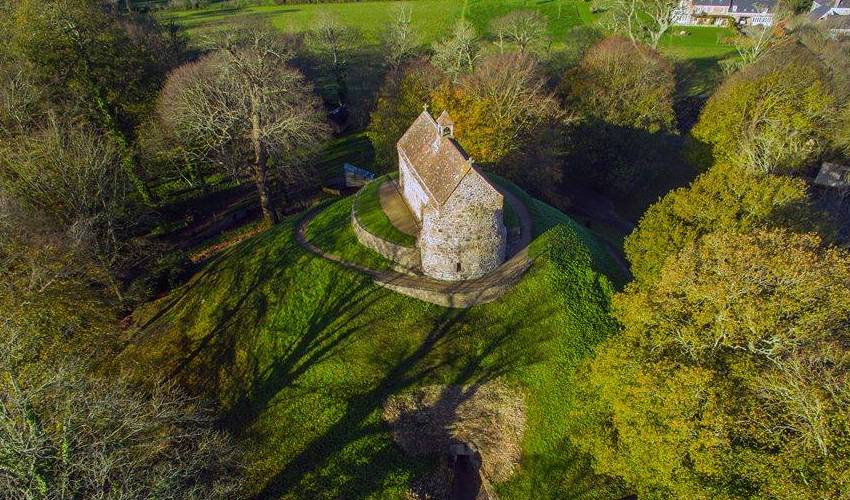
Pictured: The hoard will go on display at La Hougue Bie. (Chris Brooks Aerial Photography)
The Receiver General said: "All parties have agreed that the establishment of a trust will ensure that the coin hoard can be enjoyed and studied by future generations. The Crown will undertake the work needed to establish an independent trust, the purpose of which will be to promote scientific and educational research into the hoard."
With covid stretching public finances, it may be a relief to some to note that the purchase will not be funded directly by taxpayers.
In his November letter to the Chief Minister, Mr Corrigan pointed out that the Office of the Chief Executive did not have enough money to buy the hoard, but that Ministers were at the time looking at using the ‘Civil Asset Recovery Fund’ instead - essentially seized money that was derived from corruption in Nigeria during the military regime of General Sani Abacha in the 1990s.
Yesterday, that decision was confirmed.
Treasury Minister Deputy Susie Pinel said she regarded it as “appropriate” that cash was taken from this source.
In the near-decade since Mr Miles and Mr Mead’s find, Express understands that other ‘significant’ treasures have since been unearthed by other islanders - but not declared publicly. It's rumoured that these finders have been waiting patiently for the Le Câtillon saga to conclude to decide their next steps.
There are fears among some that yesterday’s £4.25m announcement may trigger the starting pistol on a flurry of requests aiming to get their potentially "inflated" payment before clear rules are drawn up, and set down in law by States Members.
“We believe that if the island had in place a fit-for-purpose Treasure Law, similar to that in the UK and the Isle of Man, appropriate procedures would have been followed and this situation would not have arisen,” said Heritage Chair Tim Brown.
However, there’s not long left for anyone who does wish to take advantage, with a new law promised before the end of this States Assembly term.
“We are pleased that the Government has committed to bringing forward this much-needed, modern legislation and we look forward to working with them on it,” Mr Brown added.
Comments
Comments on this story express the views of the commentator only, not Bailiwick Publishing. We are unable to guarantee the accuracy of any of those comments.